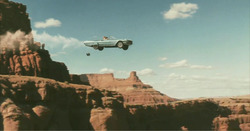Driving Off The Edge
 A car drives straight off the edge of a cliff that is 80 m high. At the scene of the accident you note that the point of impact is 160m from the base of the cliff. How fast was the car traveling in m/s when it went over the cliff?
A car drives straight off the edge of a cliff that is 80 m high. At the scene of the accident you note that the point of impact is 160m from the base of the cliff. How fast was the car traveling in m/s when it went over the cliff?
Consider g = 1 0 m/s 2
The answer is 40.
This section requires Javascript.
You are seeing this because something didn't load right. We suggest you, (a) try
refreshing the page, (b) enabling javascript if it is disabled on your browser and,
finally, (c)
loading the
non-javascript version of this page
. We're sorry about the hassle.
5 solutions
we know that a = t 2 2 d where a=acceleration, d=distance,t=time incase u = 0 . we get t = 1 0 2 × 8 0 since a=g= 1 0 m / s 2 t = 4 s e c v = t d v = 4 1 6 0 so v = 4 0 m / s
a = t v − u 2 v − u = a v e r a g e − s p e e d u=initial velocity=0 2 v = a v e r a g e − s p e e d t d = a v e r a g e − s p e e d t d = 2 v v = t 2 d a = t v − u a = t t 2 d − 0 a = t 2 2 d
For the motion of bodies in horizontal projection, as this case, is governed by some laws of motion from which we can derive certain relation of the Horizontal Distance covered ( R ) and Vertical height ( h ) , and the initial velocity ( u ) , such that
R = u ⋅ g 2 h
⇒ 1 6 0 = u ⋅ 1 0 2 ⋅ 8 0
⇒ u = F o r t y m s − 1
Arya :)
Right answer
can u tell the derivation of that formula?????
since it went over the cliff horizontally with horizontal velocity. Vertical velocity is 0 . acclereration is -10 . displacement is -80. by using v^2=u^2 + 2as you can find out the initial velocity. ps , using sign convention
- Time to touch the ground:
- 8 0 = 5 t 2
- Therefore t = 4
- u = s m = 4 1 6 0 = 4 0
In the vertical direction-- when the car just takes off from the cliff, it has got only initial horizontal velocity and zero initial vertical velocity. However, there is no acceleration in the horizontal direction and the acceleration in the vertical direction is acceleration due to gravity, g(10 m/s²). The distance covered in the horizontal direction is 160m and that in the vertical direction is 80m.
Vertical motion: We apply the equation of motion, h = ut + 1/2 gt². Here u = 0 and h = 80. Substituting we get, t = 4s.
Horizontal motion-- Since there is no acceleration in the horizontal direction, s = vt where s is the distance covered and v is velocity in the vertical direction. Substituting for time from above, we get v = s/t = 160/4 = 40 m/s.